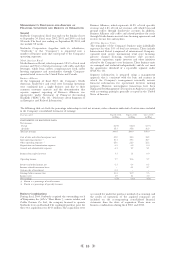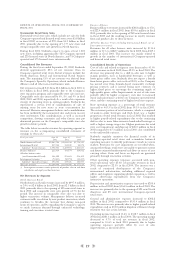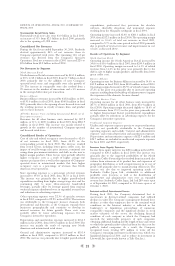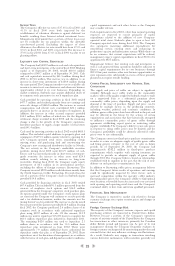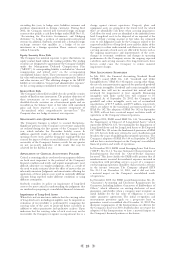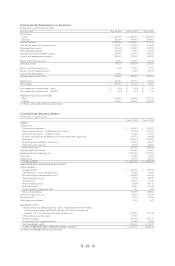Starbucks 2002 Annual Report Download - page 9
Download and view the complete annual report
Please find page 9 of the 2002 Starbucks annual report below. You can navigate through the pages in the report by either clicking on the pages listed below, or by using the keyword search tool below to find specific information within the annual report.
23
exceeding five years, to hedge assets, liabilities, revenues and
purchases denominated in foreign currencies. During fiscal
2002, the Company entered into forward foreign exchange
contracts that qualify as cash flow hedges under SFAS No. 133,
“Accounting for Derivative Instruments and Hedging
Activities,” to hedge a portion of anticipated international
revenue. In addition, Starbucks entered into a forward foreign
exchange contract that qualifies as a hedge of its net
investment in a foreign operation. These contracts expire
within 24 months.
Equity Security Price Risk
The Company has minimal exposure to price fluctuations on
equity mutual funds within the trading portfolio. The trading
securities are designated to approximate the Company’s liability
under the Management Deferred Compensation Plan
(“MDCP”). A corresponding liability is included in “Accrued
compensation and related costs” on the accompanying
consolidated balance sheets. These investments are recorded at
fair value with unrealized gains and losses recognized in “Interest
and other income, net.” The offsetting changes in the MDCP
liability are recorded in “General and administrative expenses”
on the accompanying consolidated statements of earnings.
Interest Rate Risk
The Company’s diversified available-for-sale portfolio consists
mainly of fixed income instruments.The primary objectives of
these investments are to preserve capital and liquidity.
Available-for-sale securities are of investment grade and are
recorded on the balance sheet at fair value with unrealized
gains and losses reported as a separate component of
“Accumulated other comprehensive income/loss.” The
Company does not hedge its interest rate exposure.
SEASONALITY AND QUARTERLY RESULTS
The Company’s business is subject to seasonal fluctuations.
Significant portions of the Company’s net revenues and profits
are realized during the first quarter of the Company’s fiscal
year, which includes the December holiday season. In
addition, quarterly results are affected by the timing of the
opening of new stores, and the Company’s rapid growth may
conceal the impact of other seasonal influences. Because of the
seasonality of the Company’s business, results for any quarter
are not necessarily indicative of the results that may be
achieved for the full fiscal year.
APPLICATION OF CRITICAL ACCOUNTING POLICIES
Critical accounting policies are those that management believes
are both most important to the portrayal of the Company’s
financial condition and results, and require management’s most
difficult, subjective or complex judgments, often as a result of
the need to make estimates about the effect of matters that are
inherently uncertain. Judgments and uncertainties affecting the
application of those policies may result in materially different
amounts being reported under different conditions or using
different assumptions.
Starbucks considers its policy on impairment of long-lived
assets to be most critical in understanding the judgments that
are involved in preparing its consolidated financial statements.
Impairment of Long-lived Assets
When facts and circumstances indicate that the carrying values
of long-lived assets, including intangibles, may be impaired, an
evaluation of recoverability is performed by comparing the
carrying value of the assets to projected future cash flows in
addition to other quantitative and qualitative analyses. Upon
indication that the carrying value of such assets may not be
recoverable, the Company recognizes an impairment loss as a
charge against current operations. Property, plant and
equipment assets are grouped at the lowest level for which
there are identifiable cash flows when assessing impairment.
Cash flows for retail assets are identified at the individual store
level. Long-lived assets to be disposed of are reported at the
lower of their carrying amount or fair value, less estimated
costs to sell. Judgments made by the Company related to the
expected useful lives of long-lived assets and the ability of the
Company to realize undiscounted cash flows in excess of the
carrying amounts of such assets are affected by factors such as
the ongoing maintenance and improvements of the assets,
changes in economic conditions and changes in operating
performance. As the Company assesses the ongoing expected
cash flows and carrying amounts of its long-lived assets, these
factors could cause the Company to realize material
impairment charges.
NEW ACCOUNTING STANDARDS
In July 2001, the Financial Accounting Standards Board
(“FASB”) issued SFAS No. 142, “Goodwill and Other
Intangible Assets.” SFAS No. 142 requires, among other things,
the use of a nonamortization approach for purchased goodwill
and certain intangibles. Goodwill and certain intangibles with
indefinite lives will not be amortized but instead will be
reviewed for impairment at least annually. Remaining
intangibles with finite useful lives will continue to be
amortized. As of September 29, 2002, the Company had
goodwill and other intangible assets, net of accumulated
amortization, of $19.9 million and $9.9 million, respectively,
which are subject to the transitional assessment provisions of
SFAS No. 142.The adoption of SFAS No. 142 on September
30, 2002, will not have a material impact on future results of
operations or the Company’s financial position.
In August 2001, FASB issued SFAS No. 144,“Accounting for
the Impairment or Disposal of Long-Lived Assets,” which
supercedes SFAS No. 121,“Accounting for the Impairment of
Long-Lived Assets and for Long-Lived Assets to Be Disposed
Of.” SFAS No. 144 retains the fundamental provisions of SFAS
No. 121, but sets forth new criteria for asset classification and
broadens the scope of qualifying discontinued operations. The
Company’s adoption of SFAS No. 144 on September 30, 2002
will not have a material impact on the Company’s consolidated
financial position and results of operations.
In November 2001, FASB issued Emerging Issues Task Force
(“EITF”) No. 01-14,“Income Statement Characterization of
Reimbursements Received for ‘Out-of-Pocket’ Expenses
Incurred.”This Issue clarifies the FASB staff ’s position that all
reimbursements received for incidental expenses incurred in
conjunction with providing services as part of a company’s
central ongoing operations should be characterized as revenue
in the income statement. The Company adopted EITF
No. 01-14 on December 31, 2001, and it did not have
amaterial impact on the Company’s consolidated results
of operations.
In November 2002, the FASB issued Interpretation No. 45,
“Guarantor’s Accounting and Disclosure Requirements for
Guarantees, Including Indirect Guarantees of Indebtedness of
Others,” which elaborates on existing disclosure of most
guarantees, and clarifies when a company must recognize an
initial liability for the fair value of obligations it assumes
under guarantee agreements. The initial recognition and
measurement provisions apply on a prospective basis to
guarantees issued or modified after December 31, 2002. The
disclosure requirements of the Interpretation are effective for
the Company’s fiscal year 2003. Starbucks does not expect the
adoption of this Interpretation to have a material impact on
the Company’s financial position or disclosures.




